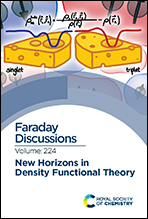Weight dependence of local exchange–correlation functionals in ensemble density-functional theory: double excitations in two-electron systems
Abstract
Gross–Oliveira–Kohn (GOK) ensemble density-functional theory (GOK-DFT) is a time-independent extension of density-functional theory (DFT) which allows the computation of excited-state energies via the derivatives of the ensemble energy with respect to the ensemble weights. Contrary to the time-dependent version of DFT (TD-DFT), double excitations can be easily computed within GOK-DFT. However, to take full advantage of this formalism, one must have access to a weight-dependent exchange–correlation functional in order to model the infamous ensemble derivative contribution to the excitation energies. In the present article, we discuss the construction of first-rung (i.e., local) weight-dependent exchange–correlation density-functional approximations for two-electron atomic and molecular systems (He and H2) specifically designed for the computation of double excitations within GOK-DFT. In the spirit of optimally-tuned range-separated hybrid functionals, a two-step system-dependent procedure is proposed to obtain accurate energies associated with double excitations.

- This article is part of the themed collection: New horizons in density functional theory


 Please wait while we load your content...
Please wait while we load your content...